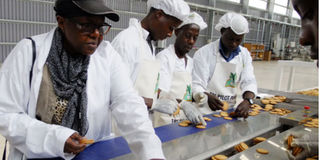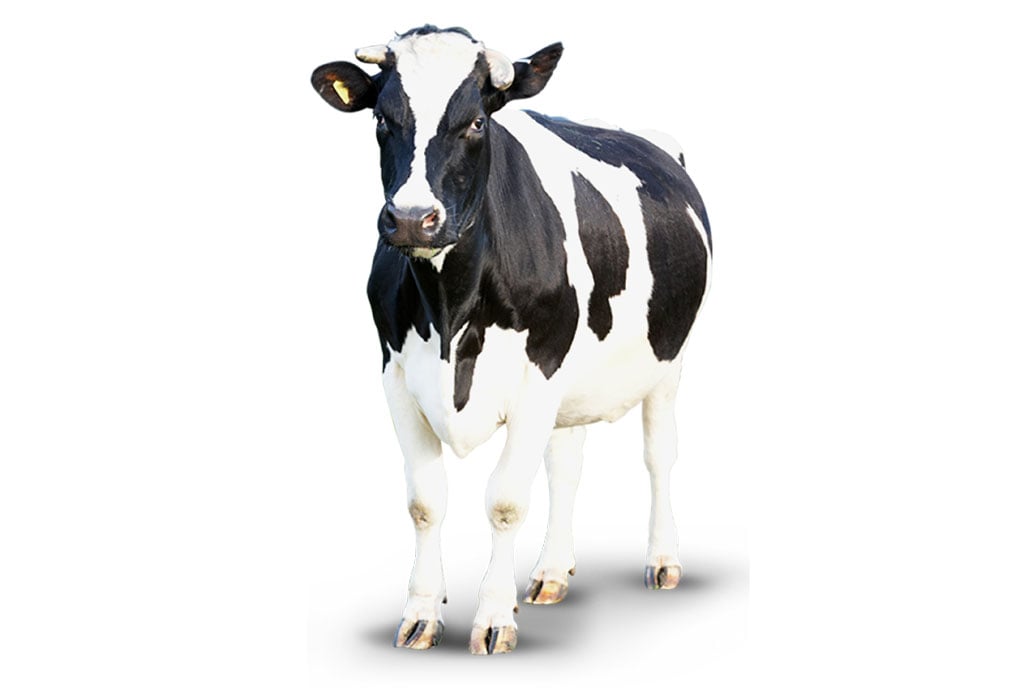10 years of transforming the banana into an industrial crop

Tooke biscuits being manufactured at the factory under Muranga’s close supervision. COURTESY PHOTOS.
The wealth in matooke
Economically: At full processing capacity, matooke could significantly supplement the value of wheat in the economy and in domestic use for functions such as baking and breakfast dishes by 50 per cent. In practical terms, this means we can import half the wheat we are currently importing since we don’t grow wheat in Uganda, and replace its uses with matooke flour or products. We could have matooke biscuits, cornflakes, flakes, name it.
Nutritionally: Because it is rich in starch, matooke is a good energy providing food. Muranga in her research found that matooke was actually more starch than water, a property that made it as valuable as wheat when it comes to food processing. “I realised that fresh, matooke like most other staple foods, has too much water which increased when cooked and mashed. A child would have to eat loads of it to get enough nutrients from it hence the malnutrition. It would need to be expanded as porridge or cereal to allow for more nutrients in smaller contents like is done with maize. But matooke is very rich in energy.”
A fortune for farmers on the ground
The factory in Bushenyi when functioning full capacity would process all the available matooke in the country in less than a month although Uganda by far produces the largest quantity of matooke in the region. What this means is that wheat imports can be replaced by matooke by half. This would give matooke farmers a chance to earn from their produce as there would be more factories and products being produced from matooke. There is an unfulfilled market for matooke farmers. “With value addition processing at its full potential, matooke farmers can earn four times more profit,” she says.
For now, the initiative organises trainings for farmers on sustainable banana production skills including proper matooke farming and pest and disease fighting techniques. The trainings are done at a 24 acre model farm run by the Initiative in Bushenyi. The trainings have also yielded corporatives evolving from farmer associations in a bid to reach the farmer on the ground.
Special treasure to Uganda
The banana processing industry is unique to Uganda in the region especially because we have high banana production capacity. Muranga was the first one to research into the banana and discover its properties that qualify it to be an industrial crop from which numerous versions of products can be processed. “While matooke processing can be duplicated, no other country has the same home advantage and potential as we do in the region. We have, however, also taken legal procedures to protect our rights,” she explains.
I first met Rev Prof Florence Isabirye Muranga at Makerere University some years ago. I cannot recall when or trace the article I wrote about her then but I remember our encounter, two things in particular; her conviction about the untapped potential of the matooke (banana) plant and her office which spoke to her passion for the tooke plant before she said anything herself.
There was particularly an imposing painting of a tooke plant on one side of the wall in her office that made quite an impression. Again, I cannot quite make out the details of the painting, but its general effect stuck with me.
Muranga estimates that this could have been about 10 years ago. “I was at Makerere Food Science department then,” she offers, a nostalgic smile on her face.
Her excitement about her study discoveries was infectious. “I believe we can get more from matooke than we have realised. This plant has a potential to transform lives and our country economically; it might be our undiscovered treasure yet,” I remember her saying then.
Muranga’s big discovery was that matooke contained starch, a property which meant that scientifically it was, like wheat, manipulatable.
Catching up
The Professor’s circumstances when I go to meet her early this year have since changed. For one, it is not in her office that we meet but rather her boardroom. None of the artwork and décor in the room stand out this time round.
However, in a corner is a tray that bears proof of what she talked about then; an assortment of food products processed from matooke - Tooke biscuits; raw tooke and instant porridge flour from which she later shows me how to make porridge and solid food; matooke flakes for cereal, among other products.
“Let us just say that whatever you can make out of wheat, you can also make from matooke,” she says calmly, with more gratification than excitement this time round, with good reason.
Events have over the years since we first met in her office at Makerere colluded to bring her dreams to fruition, among the most fundamental of these being an encounter with the President in 2005, which eventually yielded the Presidential Initiative on Banana Industrial Development (PIBID) in 2007. This initiative, for which Muranaga is the Executive Director, is responsible for the range of tooke (banana) products now on the market.
“One of the professors I met in German truly opened my eyes to what I had discovered with my PhD research in the banana when he said ‘What you have here is gold. This can turn around the fortunes of the farmer in your country’,” recounts Muranga of one other turning point in the journey that has led her to the point in her life where she is founder and head of the only banana processing industry/initiative in the region.
The beginning of a dream
It all began from an observant young girl’s curiosity, which years later yielded an academic research that eventually culminated into a whole industry.
“Growing up in Busoga, we ate a lot of matooke. The general public perception was that matooke was nothing but water nutritionally.
But while the children who grew up being fed on loads of matooke were largely malnourished, the women who also largely fed on the same matooke were quite voluminous.
“These were the questions that eventually guided my choice to study matooke,” she explains.
Muranga belonged to the pioneer Food Science class at Makerere University in 1998. There, she also realised there was literature and studies on every food but her beloved banana, a staple for the poorer households in the country, including in her region of Busoga.
“I remember thinking to myself that we could be eating poison and no one cares; there was not a single study on bananas anywhere!” She determined to leave a textbook on bananas on the shelf, which became another motivation.
Still up to the challenge
It has been 10 years with matooke and Muranga perceives her work as a spiritual duty. She explains; “My prayer was always that I would invest time and energy in research projects useful and beneficial to humanity, not just to stock up on the literature on the shelves. I, therefore, believe that I was spiritually led to the banana.”
At the moment, PIBID has almost completed first and second stages partly evidenced by the 24 acre model farm in Bushenyi, efforts to build capacity for rural farmers in new production technologies, a matooke processing factory, among others. There are still the objectives of ascertaining sustainable processing of quality market-driven products, and many more.
It is all well because Muranga seems to have just started. When she tells you about the things yet to be done, her enthusiasm is palpable. In fact, according to her, she might be well on her way but she is only just beginning. There is still work to be done, but Muranga is still up to the challenge.
How to get the best of matooke
As a meal, especially for children
For a mother feeding her children on matooke, Muranga offers the following insights into how to make the best of a matooke meal;
• In children, you need to compliment matooke meals with more nutritious additions such as breastmilk since they cannot consume the large quantities required to provide them enough nutrients. The processed matooke products would otherwise be more nutritious than fresh matooke for children.
• For the weaned children, malnutrition is more likely if you are feeding the child on a predominantly matooke diet. You would get more value from processed matooke products which are expanded to add more carbohydrate nutrients.
• Matooke products are good for diabetics because they have no added sugars.
In the garden
A banana plant takes about eight months to a year to yield to grow to maturity. Under modified farming however, it takes only seven months. For those looking to grow matooke in your backyard or on large scale, she offers the following tips:
• Plant your suckers in deep pits so they will withstand strong winds or rain.
• Mulch, irrigate and intercrop with vegetables such as beans and peas to help fix nutrients back into the soild so it is rich enough to nourish the banana plant.
• Prune and ensure there is only one flowering sucker at a time on a plant to avoid competition for nutrients.
• When you weed, do not interfere with the root system as this is what feeds and holds the plant steady when storm and winds come.
FACTFILE
Rev Prof Florence Isabirye Muranga is the Executive Director of the Presidential Initiative on Banana Industrial Development. She is married to Manuel Muranga since 19758. They have two sons.
• An associate chaplain at St Francis Chapel for over 14 years, Muranga is retired but still ministers.
• She is also a member of Makerere University’s Visitation Committee heading investigations into student affairs.
Education:
Muranga studied in Kabuli in Busoga then went on to Gayaza High School for her Secondary School education. She holds the following qualifications:
• Bachelor’s degree of Science and Diploma in Education from Makerere University (1975)
• Masters in Food Science from University of Reading in Europe (1990)
• PhD in Biochemistry from Makerere University (2000).
The focus for Muranga’s PhD was distinguishing the unique properties of banana starch.
It was findings from her research that President Museveni offered to finance to transform into commercial benefits for farmers, resulting in establishment of PIBID in 2007 premised on value addition to the banana.
When you remember me:
“I want to be remembered as having been accountable for all resources and opportunities within my reach,” says Muranga. Throughout the 10 years of PIBID, only a single turbulence is publicly known when in 2012 there were questions about the appropriation of Shs40bn by the Initiative.
Kenneth Asiimwe, PIBID head Public Relations and Communications, explains; “It was an accountability issue which was settled. Whatever was being queried was found existent on ground in Bushenyi. The facility is open to whoever is interested.”




